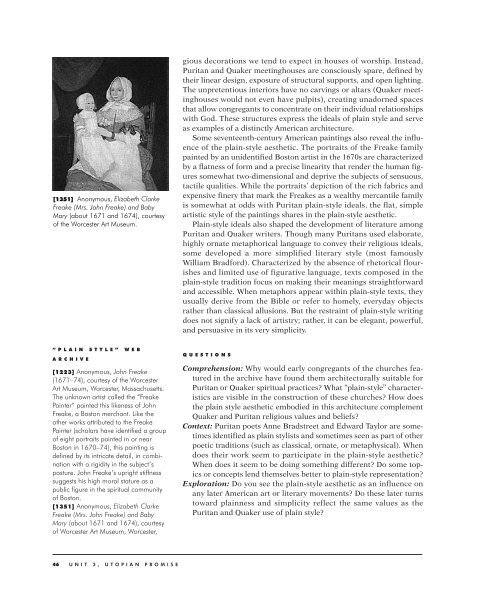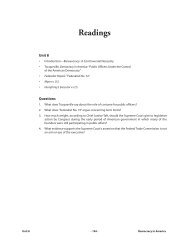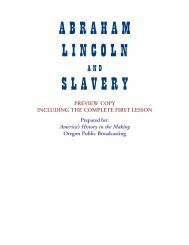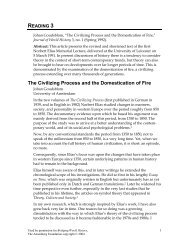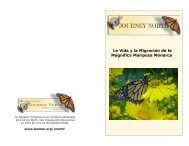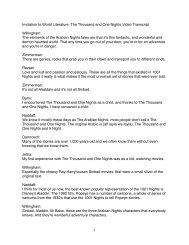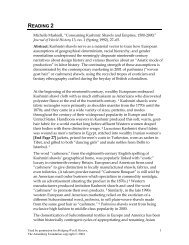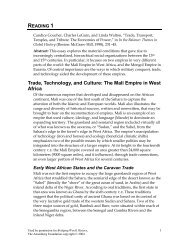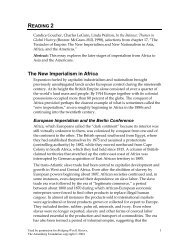UTOPIAN PROMISE - Annenberg Media
UTOPIAN PROMISE - Annenberg Media
UTOPIAN PROMISE - Annenberg Media
You also want an ePaper? Increase the reach of your titles
YUMPU automatically turns print PDFs into web optimized ePapers that Google loves.
[1351] Anonymous, Elizabeth Clarke<br />
Freake (Mrs. John Freake) and Baby<br />
Mary (about 1671 and 1674), courtesy<br />
of the Worcester Art Museum.<br />
“PLAIN STYLE” WEB<br />
ARCHIVE<br />
[1223] Anonymous, John Freake<br />
(1671–74), courtesy of the Worcester<br />
Art Museum, Worcester, Massachusetts.<br />
The unknown artist called the “Freake<br />
Painter” painted this likeness of John<br />
Freake, a Boston merchant. Like the<br />
other works attributed to the Freake<br />
Painter (scholars have identified a group<br />
of eight portraits painted in or near<br />
Boston in 1670–74), this painting is<br />
defined by its intricate detail, in combination<br />
with a rigidity in the subject’s<br />
posture. John Freake’s upright stiffness<br />
suggests his high moral stature as a<br />
public figure in the spiritual community<br />
of Boston.<br />
[1351] Anonymous, Elizabeth Clarke<br />
Freake (Mrs. John Freake) and Baby<br />
Mary (about 1671 and 1674), courtesy<br />
of Worcester Art Museum, Worcester,<br />
46 UNIT 3, <strong>UTOPIAN</strong> <strong>PROMISE</strong><br />
gious decorations we tend to expect in houses of worship. Instead,<br />
Puritan and Quaker meetinghouses are consciously spare, defined by<br />
their linear design, exposure of structural supports, and open lighting.<br />
The unpretentious interiors have no carvings or altars (Quaker meetinghouses<br />
would not even have pulpits), creating unadorned spaces<br />
that allow congregants to concentrate on their individual relationships<br />
with God. These structures express the ideals of plain style and serve<br />
as examples of a distinctly American architecture.<br />
Some seventeenth-century American paintings also reveal the influence<br />
of the plain-style aesthetic. The portraits of the Freake family<br />
painted by an unidentified Boston artist in the 1670s are characterized<br />
by a flatness of form and a precise linearity that render the human figures<br />
somewhat two-dimensional and deprive the subjects of sensuous,<br />
tactile qualities. While the portraits’ depiction of the rich fabrics and<br />
expensive finery that mark the Freakes as a wealthy mercantile family<br />
is somewhat at odds with Puritan plain-style ideals, the flat, simple<br />
artistic style of the paintings shares in the plain-style aesthetic.<br />
Plain-style ideals also shaped the development of literature among<br />
Puritan and Quaker writers. Though many Puritans used elaborate,<br />
highly ornate metaphorical language to convey their religious ideals,<br />
some developed a more simplified literary style (most famously<br />
William Bradford). Characterized by the absence of rhetorical flourishes<br />
and limited use of figurative language, texts composed in the<br />
plain-style tradition focus on making their meanings straightforward<br />
and accessible. When metaphors appear within plain-style texts, they<br />
usually derive from the Bible or refer to homely, everyday objects<br />
rather than classical allusions. But the restraint of plain-style writing<br />
does not signify a lack of artistry; rather, it can be elegant, powerful,<br />
and persuasive in its very simplicity.<br />
QUESTIONS<br />
Comprehension: Why would early congregants of the churches featured<br />
in the archive have found them architecturally suitable for<br />
Puritan or Quaker spiritual practices? What “plain-style” characteristics<br />
are visible in the construction of these churches? How does<br />
the plain style aesthetic embodied in this architecture complement<br />
Quaker and Puritan religious values and beliefs?<br />
Context: Puritan poets Anne Bradstreet and Edward Taylor are sometimes<br />
identified as plain stylists and sometimes seen as part of other<br />
poetic traditions (such as classical, ornate, or metaphysical). When<br />
does their work seem to participate in the plain-style aesthetic?<br />
When does it seem to be doing something different? Do some topics<br />
or concepts lend themselves better to plain-style representation?<br />
Exploration: Do you see the plain-style aesthetic as an influence on<br />
any later American art or literary movements? Do these later turns<br />
toward plainness and simplicity reflect the same values as the<br />
Puritan and Quaker use of plain style?


